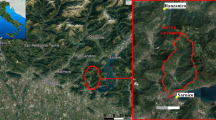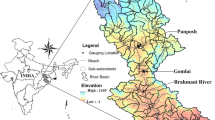Abstract
Mediterranean regions, with climate variability and long histories of human disturbance, are particularly vulnerable to soil erosion and sediment redistribution. This study examines surface soil stability and stream energy of the 243 km2 Inachos River watershed in the northeast Peloponnese, Greece. This mountainous, semi-arid Mediterranean region has an extensive history of human activity. Soil loss and stream energy are each quantified by applying the Revised Universal Soil Loss Equation (RUSLE) using the Unit Stream Power Erosion Deposition (USPED) method and the specific stream power approach to the main river channels. These models are used to indicate the spatial variability in geomorphic activity. Results show an average soil loss for the Inachos River catchment of 15.0 t ha−1 a−1, exceeding the rate of soil formation. Values range from nil in low gradient environments to 4287 t ha−1 a−1 in steep, mountainous regions. Gradient and rainfall erosivity are the primary factors. High specific stream power in the upper watershed exceeds 17,100 W m−2, resulting in the mobilization of sediment into channelized debris flows that transport sediment from the steep hillslopes. Episodic high-magnitude precipitation events promote the longitudinal connectivity of the catchment. The long occupation and agricultural history, extending as far back as Neolithic time, has accelerated downslope sediment transport.





Similar content being viewed by others
References
Anagnostoudi Th, Papadopoulou S, Ktenas D, Gkadri E, Pyliotis I, Kokkidis N, Panagiotopoulos V (2010) The Olvios, Rethis and Inachos drainage system evolution and human activities influence of their future evolution. Proceedings of the 12th international congress of the geological society of Greece, Patras
Arhonditsis G, Giourga C, Loumou A, Koulouri M (2002) Quantitative assessment of agricultural runoff and soil erosion using mathematical modeling: applications in the Mediterranean region. Environ Manag 30(3):434–453
Arnoldus HMJ (1980) An approximation of the rainfall factor in the universal soil loss equation. In: De Boodt M, Gabriels D (eds) Assessment of erosion. Wiley, Chichester, pp 127–132
Church M, Ferguson RI (2015) Morphodynamics: rivers beyond steady state. Water Resour Res 51:1883–1897
Demirci A, Karaburum A (2012) Estimation of soil erosion using RUSLE in a GIS framework: a case study in the Buyukcekmece Lake watershed, northwest Turkey. Environ Earth Sci 66:903–913
Eaton BC (2013) Hydraulic geometry: Empirical investigations and theoretical approaches. In: Shroder J, Wohl E (eds) Treatise on geomorphology. Academic Press, San Diego, pp 313–329
Eaton BC, Church M (2011) A rational sediment transport scaling relation based on dimensionless stream power. Earth Surf Process Landforms 36:901–910
Efthimiou N (2016) Performance of the RUSLE in Mediterranean mountainous catchments. Environ Process 3:1001–1019
European Soil Data Centre (2015) Map of soils of Greece, 1967. Soils map of Greece. http://esdac.jrc.ec.europa.eu/resource-type/national-soil-maps-eudasm?field_data_continent_tid_selective=1266&field_data_country_country_selective=GR&field_data_cont_coverage_value. Accessed 23 July 2015
Farhan Y, Nawaiseh S (2015) Spatial assessment of soil erosion risk using RUSLE and GIS techniques. Environ Earth Sci 74:4649–4669
Ferguson RI (2005) Estimating critical stream power for bedload transport calculations in gravel-bed rivers. Geomorphology 70:33–41
Ferreira V, Panagopoulos T (2014) Seasonality of soil erosion under Mediterranean conditions at the Alqueva Dam watershed. Environ Manag 54:67–83
Ferro V, Porto P (1999) A comparative study of rainfall erosivity estimation for southern Italy and southeastern Australia. Hydrol Sci 44(1):3–24
Ferro V, Giordano F, Iovino M (1991) Isoerosivity and erosion risk map for Sicily. Hydrol Sci 36(6):549–564
Flint JJ (1974) Stream gradient as a function of order, magnitude and discharge. Water Resour Res 10(5):969–973
Flores AN, Bledsoe BP, Cuhaciyan CO. Wohl EE (2006) Channel-reach morphology dependence on energy, scale, and hydroclimatic processes with implications for prediction using geospatial data. Water Resour Res 42:W06412. https://doi.org/10.1029/2005WR004226
Fuchs M (2007) An assessment of human versus climatic impacts on Holocene soil erosion in NE Peloponnese, Greece. Quatern Res 67:349–356
Fuchs M, Lang A, Wagner GA (2004) The history of Holocene soil erosion in the Phlious Basin, NE Peloponnese Greece, based on optical dating. Holocene 14(3):334–345
Gaki-Papanastasiou K (1991) The geomorphological development of the wider region of the Argolic plain in the Quaternary (Doctoral dissertation). National and Kapodistrian University of Athens, Athens
Garcia Rodriguez JL, Gimenez Suarez MC (2012) Methodology for estimating the topographic factor LS of RUSLE3D and USPED using GIS. Geomorphology 175–176:98–106
Gouma M, van Wijngaarden GJ, Soetens S (2011) Assessing the effects of geomophological processes on archaeological densities: a GIS case study on Zakynthos Island, Greece. J Archaeolog Sci 38:2714–2725
Grabowski RC, Surian N, Gurnell AM (2014) Characterizing geomorphological change to support sustainable river restoration and management. WIREs Water 1:483–512
Helenic National Meteorological Service (2016) Climatology (Data file). http://www.hnms.gr/hnms/english/climatology/climatology_html. Accessed 15 Aug 2016
Hill J, Schutt B (2000) Mapping complex patterns of erosion and stability in dry Mediterranean ecosystems. Remote Sens Environ 74:557–569
Hydroscope (2016) Hydrological data (data file). http://main.hydroscope.gr/. Accessed 7 Sept 2016
Jaeger KL, Montgomery DR, Bolton SM (2007) Channel and perennial flow initiation in headwater streams: management implications of variability in source-area size. Environ Manag 40:775–786
Jain V, Preston N, Fryirs K, Brierley G (2006) Comparative assessment of three approaches for deriving stream power plots along long profiles in the upper Hunter river catchment, New South Wales, Australia. Geomorphology 74:297–317
Kinnell PIA (2015) Geographic variation of USLE/RUSLE erosivity and erodibility factors. J Hydrol Eng 20(6):C4014012. https://doi.org/10.1061/(ASCE)HE.1943-5584.000114. Accessed 15 Sept 2016
Knighton AD (1999) Downstream variation in stream power. Geomorphology 29:293–306
Kouli M, Soupios P, Vallianatos F (2009) Soil erosion prediction using the revised universal soil loss equation (RUSLE) in a GIS framework, Chania, Northwestern Crete, Greece. Environ Geol 57:483–497
Marchamalo M, Hooke JM, Sandercock PJ (2016) Flow and sediment connectivity in semi-arid landscapes in SE Spain: patterns and controls. Land Degrad Dev 27:1032–1044
Mexia K (2015) Geoarchaeological observation in the wider area of Nemea using airphotos and GIS. Earth Sci Inf 8:269–278
Ministry of Environment, Energy and Climate Change (2011) Consultation project management of water resources—Rema Argolic Gulf (GR31). http://www.ypeka.gr/Default.aspx?tabid=922&language=en-US. Accessed 25 Oct 2016
National Cadastre and Mapping Agency SA (2016) Digital elevation model—tiled dataset (digital file). National Cadastre and Mapping Agency SA, Athens
Nicoll T, Brierley G (2017) Within-catchment variability in landscape connectivity measures in the Garang catchment, upper Yellow River. Geomorphology 277:197–209
Oliveira AH, da Silva MA, Silva MLN, Curi N, Neto GK, de Freitas DAF (2013) Development of topographic factor modeling for application in soil erosion models. In: Hernandez Soriano MC (ed) Soil processes and current trends in quality assessment. InTech. http://doi.org/10.5772/54439
Panagos P, Borrelli P, Meusburger K, van der Zanden EH, Poesen J, Alewell C (2015a) Modelling the effect of support practices (P-factor) on the reduction of soil erosion by water at European Scale. Environ Sci Policy 51:23–34
Panagos P, Borrelli P, Poesen J, Ballabio C, Lugato E, Meusburger K, Montanarella L, Alewell C (2015b) The new assessment of soil loss by water erosion in Europe. Environ Sci Policy 54:438–447
Parker C, Clifford NJ, Thorne CR (2011) Understanding the influence of slope on the threshold of coarse grain motion. Geomorphology 126:51–65
Phillips RTJ, Desloges JR (2014) Glacially conditioned specific stream powers in low-relief river catchments of the southern Laurentian Great Lakes. Geomorphology 206:271–287
Poeppl RE, Keesstra SD, Maroulis J (2017) A conceptual connectivity framework for understanding geomorphic change in human-impacted fluvial systems. Geomorphology 277:237–250
Poesen JWA, Hooke JM (1997) Erosion, flooding and channel management in Mediterranean environments of southern Europe. Prog Phys Geogr 21(2):157–199
Pope KO, van Andel TH (1984) Late Quaternary alluviation and soil formation in the southern Argolid: its history, causes and archaeological implications. J Archaeol Sci 11:281–306
Reinfelds I, Cohen T, Batten P, Brierley G (2004) Assessment of downstream trends in channel gradient, total and specific stream power: a GIS approach. Geomorphology 60:403–416
Renard KG, Foster GR, Weesies GA, McCool DK, Yoder DC (1997) Predicting soil erosion by water: a guide to conservation planning with the revised universal soil loss equation (RUSLE). USDA agriculture handbook no. 703. US Government Printing Office, Washington, DC
Saygun SD, Ozcan AU, Basaran M, Timur OB, Dolarslan M, Yilman FE, Erpul G (2014) The combined RUSLE/SDR approach integrated with GIS and geostatics to estimate annual sediment flux rates in the semi-arid catchment, Turkey. Environ Earth Sci 71:1605–1618
Spaeth KE Jr, Pierson FB Jr, Weltz MA, Blackburn WH (2003) Evaluation of USLE and RUSLE estimated soil loss on rangeland. J Range Manag 56(3):234–246
Syvitski JPM (2003) Supply and flux of sediment along hydrological pathways: research for the 21st century. Glob Planet Change 39:1–11
Terranova O, Coscarelli LA, Iaquinta CP (2009) Soil erosion risk scenarios in the Mediterranean environment using RUSLE and GIS: an application model for Calabria (southern Italy). Geomorphology 112:28–245
Thayer JB, Phillips RTJ, Desloges JR (2016) Downstream channel adjustment in a low-relief, glacially conditioned watershed. Geomorphology 262:101–111
Tsara M, Kosmas C, Kirkby MJ, Kosma D, Yassoglou N (2005) An evaluation of the PESERA soil erosion model and its application to a case study in Zakynthos, Greece. Soil Use Manag 21:377–385
van Andel TH, Zangger E, Perissoratis C (1990) Quaternary trangressive/regressive cycles in the Gulf of Argos, Greece. Quat Res 34:317–329
van Andel TH, Zangger E, Demitrack A (2010) Land use and soil erosion in prehistoric and historical Greece. J Field Archaeol 17:379–396
Vocal Ferencevic M, Ashmore P (2012) Creating and evaluating digital elevation model-based stream-power map as a stream assessment tool. River Res Appl 28:1394–1416
Williams GP (1978) Bank-full discharge of rivers. Water Resour Res 14(6):1141–1154
Wischmeier WH, Smith DD (1965) Predicting rainfall-erosion losses from cropland east of the Rocky Mountains. USDA agriculture handbook no. 282. US Government Printing Office, Washington, DC, p 47
Wischmeier WH, Smith DD (1978) Predicting rainfall erosion losses. A guide to conservation planning. USDA agriculture handbook no. 537. US Government Printing Office, Washington, DC, p 58
Wohl E, Rathburn S, Chignell S, Garrett K, Laurel D, Livers B, Patton A, Records R, Richards M, Schook DM, Suffin NA, Wegener P (2017) Mapping longitudinal stream connectivity in the Northern St. Vrain Creek watershed of Colorado. Geomorphology 277:171–181
Wolman MG (1954) A method of sampling course river-bed material. Trans Am Geophys Union 35(6):951–956
Zangger E (1993) The geoarchaeology of the Argolid. Gebr. Mann., Berlin
Acknowledgements
The authors wish to thank the support of the Western Argolid Regional Project (especially Drs. Sarah James, Scott Gallimore and William Caraher), the Canadian Institute in Greece, and the British School at Athens. Fieldwork for this project was undertaken with permits granted by the Hellenic Institute of Geology & Mineral Exploration (IGME); we thank them and the Ephorate of Antiquities of Argolida for their assistance. This work was supported by the Natural Sciences and Engineering Research Council of Canada, the Social Sciences and Humanities Research Council of Canada, and research funding from the University of Toronto.
Author information
Authors and Affiliations
Corresponding author
Rights and permissions
About this article
Cite this article
Tetford, P.E., Desloges, J.R. & Nakassis, D. Modelling surface geomorphic processes using the RUSLE and specific stream power in a GIS framework, NE Peloponnese, Greece. Model. Earth Syst. Environ. 3, 1229–1244 (2017). https://doi.org/10.1007/s40808-017-0391-z
Received:
Accepted:
Published:
Issue Date:
DOI: https://doi.org/10.1007/s40808-017-0391-z




